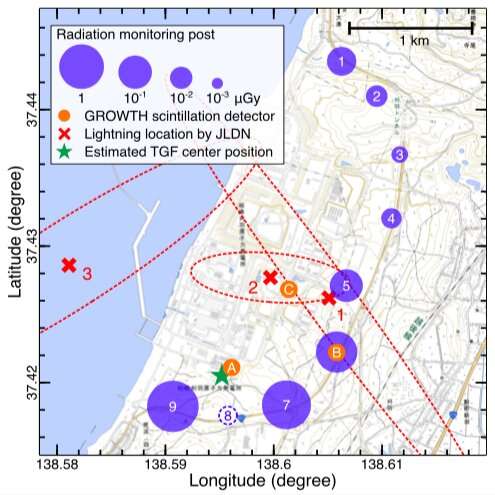August 27, 2019 feature
Studying downward terrestrial gamma-ray flashes during a winter thunderstorm

Lightning is a unique and fascinating phenomenon that has been studied for centuries. Although we now have a better understanding of this naturally occurring spectacle, many of its secrets are yet to be uncovered.
For several decades, researchers have been aware that lightning strikes are accompanied by gamma-ray flashes, a type of electromagnetic radiation. These flashes can be downward-facing (i.e. directed to the ground) or upward-facing (i.e. directed upward into space).
Most past studies have observed these flashes from space, and have thus primarily focused on upward-facing gamma-ray flashes. In an intriguing new study, a research team at the University of Tokyo and other Japanese Universities have investigated the downward gamma-ray emissions that take place during thunderstorms for the very first time. Their paper, published in Physical Review Letters, confirms that downward-facing flashes are the same as those directed upward, and that they are not harmful to people on Earth.
"Since 1990s, intense gamma-ray emissions called terrestrial gamma-ray flashes (TGFs) have been observed by in-orbit satellites coincident with lightning discharges," Yuuki Wada, one of the researchers who carried out the study, told Phys.org. "While they are usually directed from thunderstorms into space, some of them, called downward TGFs, go to the ground. However, it was difficult to measure their on-ground gamma-ray fluxes because downward TGFs take place closer to gamma-ray detectors and saturate them."
In their study, Wada and his colleagues studied gamma-ray flashes that occurred on the 24th of November 2017 during a heavy winter thunderstorm. On that date, radiation detectors installed at sea level at the Kashiwazaki-Kariwa Nuclear Power Station in Japan detected a strong burst of gamma-rays, which coincided with a powerful lightning discharge. By studying the data collected by these detectors, the researchers gathered the very first observations of lightning-associated TGFs directed to the ground.
"We used two types of radiation detectors," Wada explained. "One has better timing resolution and sensitivity to gamma rays, but could be easily saturated by high fluxes of downward TGFs. It is used to confirm the occurrence of downward TGFs. The other is gas dosimeters operated by Tokyo Electric Power Company Holdings. These have less timing resolution than the former, but stand much higher gamma-ray rates."
Remarkably, Wada and his colleagues are the first to successfully measure on-ground radiation doses of downward-facing TGFs. Moreover, by measuring the rays using multiple gas dosimeters, they achieved high-quality data at multiple observation points.
The researchers were able to ascertain the accuracy of Monte-Carlo simulations they had created, which were comparable to the high-quality data. This ultimately allowed them to uncover key physical features of downward-facing TGFs, including their origin within the thundercloud.
"TGFs are thought to originate from energetic electrons accelerating in lightning," Wada said. "However, the dense atmosphere on Earth prevents electrons from getting relativistic energy. We are convinced that observations of downward TGFs will play an important role to finding answers to this question, because they can be observed by multiple and closer on-ground apparatus."
The observations gathered by Wada and his colleagues have numerous interesting implications. Firstly, their work confirms that downward TGFs are intrinsically the same phenomenon as upward TGFs that were previously observed from space.
Their results also suggest that TGFs are fairly safe for people on the ground in the area where a thunderstorm is taking place. On the other hand, the location within a cloud where the TFG originates from might not be very safe.
In addition to broadening our understanding of gamma-ray bursts that take place during thunderstorms, the study carried out by this team of researchers unveiled some limitations of detectors that are commonly used to collect data during lightning storms. This could inform the development of new tools to improve detection, ultimately leading to the collection of higher-quality of data using radiation monitors.
"Our group is now making a new radiation-monitoring network at Kanazawa city in Japan, which is famous for powerful and frequent winter lightning," Teru Enoto, another researcher involved in the study, told Phys.org. "This network will provide us much more number of high-energy events at lightning, similar to this event. We are also collaborating with citizen supporters to cover a wider area with portable radiation detectors. We are very excited to reveal mysteries of lightning via our citizen-supporting and open-science approach."
More information: Y. Wada et al. Downward Terrestrial Gamma-Ray Flash Observed in a Winter Thunderstorm, Physical Review Letters (2019). DOI: 10.1103/PhysRevLett.123.061103
www.u-tokyo.ac.jp/focus/en/art … les/z0508_00054.html
Journal information: Physical Review Letters
© 2019 Science X Network




















